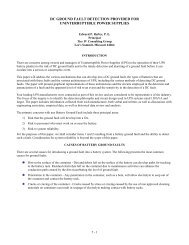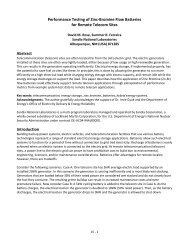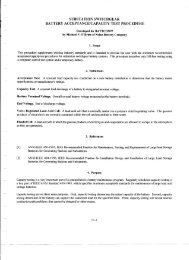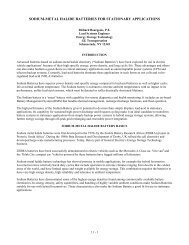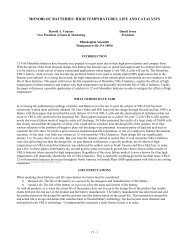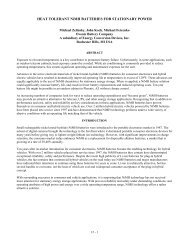ESTABLISHING VRlA BATTERY MAINTENANCE PROGRAMS ...
ESTABLISHING VRlA BATTERY MAINTENANCE PROGRAMS ...
ESTABLISHING VRlA BATTERY MAINTENANCE PROGRAMS ...
Create successful ePaper yourself
Turn your PDF publications into a flip-book with our unique Google optimized e-Paper software.
It is possible change the test results simply by changing where you place the test clamp or probe. This<br />
variable must be controlled by the user in order to obtain consistent results. Figure 1 shows the<br />
recommended test probe positions from Midtronics, Inc. which are consistent with what the IEEE Standard<br />
450-1996 shows. The person operating the test instrument must try to get the best result possible, and<br />
proper battery contact is imperative. Some experimentation might be necessary when verifying which test<br />
position gives the highest conductance (or lowest resistance) measurement for a cell. With a wide range of<br />
battery post designs, access to the battery terminals can be difficult once they are placed into service. This<br />
seems to be especially true in Uninterruptible Power Supply (UPS) cabinets, where battery cases are<br />
stacked two and three deep in a rack. Extreme caution must be used when testing these sites because of the<br />
electrical shock hazards associated with high voltage frequently found in UPS cabinets.<br />
Proper Placement of Test Probes<br />
FEMALE THREADED<br />
TERMINAL<br />
LEAD<br />
BOLTED<br />
TERMINAL<br />
Yes. Several measurements can be taken to help a battery technician identify the general condition of a<br />
system. Testing is the only way to identify what performance to expect from each battery installation. In<br />
addition to Ohmic testing, other data to consider reporting are battery and ambient temperature, individual<br />
cell and string float voltages, charge current, total site current load plus any other details observed from<br />
your visual inspection. As was suggested earlier, if the battery terminals are accessible, a measurement<br />
should be taken. The one-time test "Snap Shot" will at least give a reference point for the future. Because<br />
batteries tend to have similar discharge performance when their internal resistance is roughly the same, you<br />
want to see similar test measurements between like batteries. Unfortunately, the Ohmic Snap Shot is<br />
generally effective only in finding the most radical cell deviations when comparing the cells to each other.<br />
The ideal situation is to have data on the cells when they are new, and then continuing to gather data at<br />
regular intervals on successive service visits. This situation will let you see changes that are taking place in<br />
the battery over time. When you have the site history, it will show you what elements are affecting the<br />
battery installation. No matter what battery chemistry is deployed, operating temperature is a factor all<br />
batteries are influenced by, with no exceptions. Operate any battery at high temperatures, battery service<br />
life will be cut short. If the battery is operated at very cold temperatures, service life may be extended, but<br />
it more difficult to get the rated energy from it.



